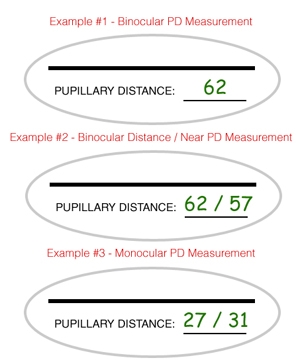The Pupilary Distance is a measurement from the center of the left pupil to the center of the right pupil in millimeters and abbreviated "PD". A pupil would be most easily explained as the black dot in your eye and is used when preparing to make prescription eyeglasses. Positioning lenses correctly in relation to the centre of the pupils is especially important for higher powered lenses due to the location of the optical centre of the lenses. A prescription order may be initially placed without a PD measurement, however our lab cannot complete the order until the PD is submitted. PD measurements are required to ensure your lenses are properly installed in the frames to match your pupil.

Example shows the wearer's PD measuring at 58 millimeters.
Measuring Your Pupillary Distance
Someone with training in the field of optics can accurately measure a person's pupillary distance. This is normally done with a small millimeter ruler referred to as a "PD stick" or with a corneal reflex pupillometer, which is a machine calibrated to help the optical professional more accurately measure the pupillary distance. There are also mobile phone and web apps that can also measure one's pupillary distance. The accuracy of the PD measurement should be precise but in many cases can be with-in a tolerance of 1mm.
Helpful Info
- 1 centimeter = 10 millimeters
- 1 inch = 25.4 millimeters
Common PD Values:
- Male Adult: 55mm - 70mm
- Female Adult: 53mm - 65mm
- Young Adult: 40mm - 55mm
Types of PD Measurements
There are three types of measurements that can be used and are usually determined by the number and/or numbers provided.
-
Binocular Distance (Common)
The most common measurement provided is the complete binocular PD measurement, which is the measurement from one pupil to the other. This is a single measurement and is usually in the range of 50mm-70mm's.
-
Binocular Distance/Near
You will see two numbers, one number will be intended for Distance and the other for Near vision. The Near PD is usually around 2-3mm's less than the Distance PD (ie. 62/60). While purchasing glasses for distance or reading, providing the intended PD may be essential in ensuring vision accuracy with your lenses. Since these are both binocular measurements, they can be found usually in the range of 50mm-70mm's.
-
Monocular
As opposed to the binocular PD, the Monocular PD measurement is the the distance from the middle of the bridge (nose) to each pupil. In less common cases you will receive a Monocular PD measurement, but is known to be more accurate. A Monocular PD contains two numbers (ie. 30/29). Each number in a Monocular PD measurement is usually in the range of 25mm-40mm's, as it usually reflects the calculated half of, and should total up to the full Binocular PD measurement.

Finding Your PD Measurement
The PD measurement is usually measured by the optical store that dispenses/crafts your prescription glasses. In rare circumstances, the prescribing doctor will measure your PD and include it in the prescription, but not often. The PD measurement is classed as a dispensing tool rather than a part of the actual prescription of the person whose eyes were tested, thus there is no obligation for a PD to be provided on patient request. However, it is essential to have this measurement in case you desire to purchase glasses online to ensure the accuracy of your lenses.
How to obtain your PD Measurement:
- Contact the last place your prescription glasses were made/crafted. This information is usually kept on file at the store that previously filled your prescription glasses. You may choose to have us contact the store/office for you, please provide us with the telephone number after you place your order.
- You can visit the prescribing eye doctors office and ask them to take this measurement for you. However, in most cases, the eye doctor is not obligated to provide this information without additional costs.
- You can visit a local optical store and ask them to take this measurement for you. However, the optical store is not obligated to provide this measurement without additional costs or without purchase.
- As a last option, you can have a friend measure it. Please do it a few times to ensure consistent reading.

























